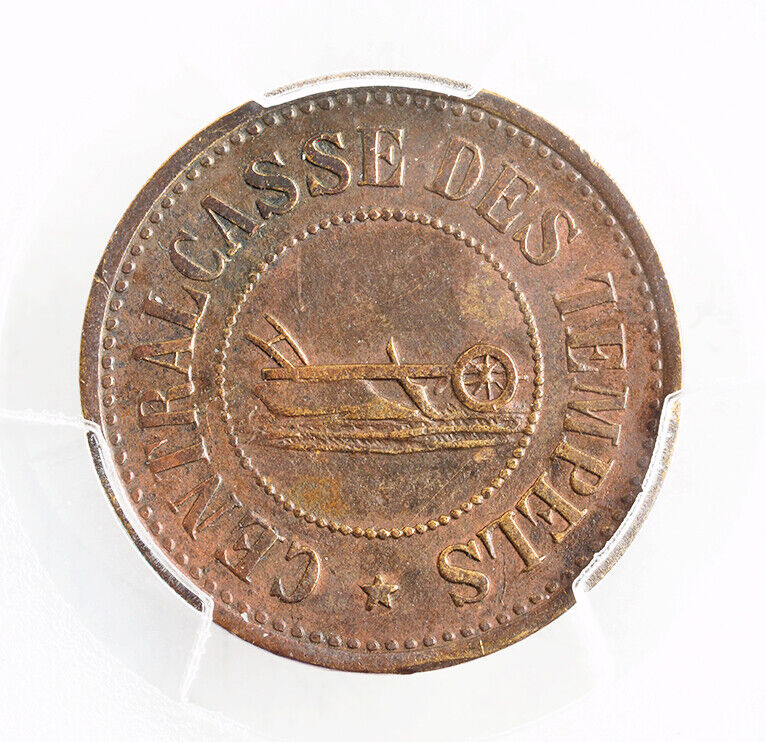-40%
1880-1917, Palestine (Ottoman), Templer Society. Brass 20 Paras Token. PCGS XF45
$ 310.99
- Description
- Size Guide
Description
CoinWorldTV1880-1917, Palestine (Ottoman), Templer Society. Brass 20 Paras Token. PCGS XF45
Mint Period: ca. 1880
Denomination: 20 Para Token (Consum Marke)
Reference: Judaic tokens & medals CC-13A.
Rare!
Condition:
Certified and graded by PCGS as XF-45!
Issuer: Bank of the Temple Society (Centralcasse des Tempels)
Area of Circulation: Haifa, Jaffa & Jerusalem in the Ottoman Palestine (today´s State of Israel)
Weight: ca 1.5gm
Diameter: 20mm
Material: Silver
Obverse:
Plough within inner circle.
Legend: * CENTRAL CASSE DES TEMPELS
Reverse:
Large value numeral (20) surrounded by legend.
Legend * CONSUM MARKE
The
German Templer Society
emerged in Germany during the mid-nineteenth century, with its roots in the Pietist movement of the Lutheran Church, and in its history a legacy of preceding centuries during which various Christian groups undertook to establish what they saw as the perfect Christian religion in preparation for Christ's promised return. The movement was founded by Christoph Hoffmann [1815-1885], who believed that humanity’s salvation lay in the gathering of God's people in a Christian community. He also believed that the second coming of Christ was imminent, and that according to Biblical prophecy it would take place in Jerusalem, where God's people were to gather as a symbol of the rebuilding of the temple. He established a number of German Templer colonies in Palestine.
Hoffmann’s thinking was inspired by the 1st century Christian community and based on Matthew’s Gospel in regard to Old Testament prophecies and their relevance to the coming of Jesus Christ. Hoffmann also believed that these "prophecies concerned mainly the founding of the Kingdom of God on earth."
Authenticity unconditionally guaranteed.
Bid with confidence!
The
German Templer colonies in Palestine
were the settlements established in Ottoman Palestine and Mandatory Palestine by the German Pietist Templer movement in the late 19th and early 20th century. During and shortly after World War II, these colonies were depopulated, and its German residents deported to Australia.
At its height, the Templer community in Palestine numbered 2,000.
On 6 August 1868, the founders of the Templers, Christoph Hoffmann and Georg David Hardegg, their families and a group of fellow Templers, left Germany for Palestine, landing in Haifa on 30 October. They had already come to the conclusion that basing themselves in Jerusalem wouldn’t be practical, planning to settle nearby, close to Nazareth, but during their journey they were advised that Haifa would be more suitable, having a good harbor and climate.
Hoffmann and Hardegg purchased land at the foot of Mount Carmel and established a colony there in 1868. At the time, Haifa had a population of 4,000. The Templers are credited today with promoting the development of the city. The colonists built an attractive main street that was much admired by the locals. It was 30 meters wide and planted with trees on both sides. The houses, designed by architect Jacob Schumacher, were built of stone, with red-shingled roofs, instead of the flat or domed roofs common in the region. Hard work, the harsh climate and epidemics claimed the lives of many before the colony became self-sustaining. Hardegg stayed in Haifa, while Hoffmann moved on to establish other colonies.
In the same year, Bahá'u'lláh, the prophet-founder of the Baháʼí Faith, arrived in the Haifa-Akka region as a prisoner of the Ottoman Empire. Years later, after his release from strict confinement, he visited the Templer Colony on Mount Carmel several times and wrote a letter to Hardegg. He asked his son, ‘Abdu’l-Baha, to build, on the alignment of the Templer Colony road (Carmel Avenue) with the shrine to the forerunner of the religion, known as "the Bab," halfway up the mountain. The conjunction of the Templer buildings and the Shrine have become the most significant landmark in the modern city of Haifa.
Hoffman established a German colony in Jaffa (today part of Tel Aviv-Yafo) in 1869. It was built at the site of a former settlement by United States Christians, which had been abandoned by then, for which reason the area is known today as the American-Germany colony of Tel Aviv. A Protestant church – Immanuel Church – and a German Consulate were built in the colony by the local German Templer residents.
The colony's oranges were the first to carry a "Jaffa orange" label, one of the better known agricultural brands in Europe, used to market Israeli oranges to this day.
In 1871, a third colony in Sarona, as the Templers' first agricultural colony, on the road from Jaffa to Nablus. In 1873 a fourth colony was established in the Valley of Refaim outside Jerusalem's Old City.
The Templers established a regular coach service between Haifa and the other cities, promoting the country's tourist industry, and made an important contribution to road construction.
Only 1$ shipping for each additional item purchased!











